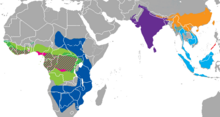
Back آكل النمل الحرشفي Arabic پانجولين ARZ বন-ৰৌ Assamese Pholidota AST Vorbumoldunol (Pholidota) AVK فولیدوتا AZB Klesih BAN Balintong (hayop) BCL Пангаліны Byelorussian Пангаліны BE-X-OLD
| Pangolins Temporal range: Middle Eocene – present
| |
|---|---|

| |
| Pangolins from families Manidae, Patriomanidae, Eomanidae and Eurotamanduidae | |
| Scientific classification | |
| Domain: | Eukaryota |
| Kingdom: | Animalia |
| Phylum: | Chordata |
| Class: | Mammalia |
| Mirorder: | Ferae |
| Clade: | Pholidotamorpha |
| Order: | Pholidota Weber, 1904 |
| Subgroups | |
|
[see classification]
| |

| |
| Ranges of living species | |
| Synonyms | |
|
list of synonyms:
| |
Pangolins, sometimes known as scaly anteaters,[12] are mammals of the order Pholidota (/fɒlɪˈdoʊtə/). The one extant family, the Manidae, has three genera: Manis, Phataginus, and Smutsia.[13] Manis comprises four species found in Asia, while Phataginus and Smutsia include two species each, all found in sub-Saharan Africa.[14] These species range in size from 30 to 100 cm (12 to 39 in). A number of extinct pangolin species are also known. In September 2023, nine species were reported.[15]
Pangolins have large, protective keratin scales, similar in material to fingernails and toenails, covering their skin; they are the only known mammals with this feature. They live in hollow trees or burrows, depending on the species. Pangolins are nocturnal, and their diet consists of mainly ants and termites, which they capture using their long tongues. They tend to be solitary animals, meeting only to mate and produce a litter of one to three offspring, which they raise for about two years. Pangolins superficially resemble armadillos, though the two are not closely related; they have merely undergone convergent evolution.
Pangolins are threatened by poaching (for their meat and scales, which are used in traditional medicine[16][17]) and heavy deforestation of their natural habitats, and are the most trafficked mammals in the world.[18] As of January 2020[update], there are eight species of pangolin whose conservation status is listed in the threatened tier. Three (Manis culionensis, M. pentadactyla and M. javanica) are critically endangered, three (Phataginus tricuspis, Manis crassicaudata and Smutsia gigantea) are endangered and two (Phataginus tetradactyla and Smutsia temminckii) are vulnerable on the Red List of Threatened Species of the International Union for Conservation of Nature.[19]
- ^ "Abstracts of Papers". Journal of Vertebrate Paleontology. 14: 1–58. 1994. Bibcode:1994JVPal..14S...1.. doi:10.1080/02724634.1994.10011592.
- ^ Lane, Henry Higgins (1910) "A corrected classification of the edentates." Science, new ser., vol. 31, pp. 913-914
- ^ Zagorodniuk, I. (2008). "Scientific names of mammal orders: from descriptive to uniform". Visnyk of Lviv University. Biology (48): 33–43.
- ^ Haeckel, Ernst (1895). Systematische Phylogenie: Wirbelthiere (in German). Vol. T.3. Berlin: G. Reimer.
- ^ Cope, E. D. (1889). "The Edentata of North America". American Naturalist. 23 (272): 657–664. doi:10.1086/274985. S2CID 83633905.
- ^ Kenneth E. Kinman (1994) "The Kinman System: Toward a Stable Cladisto-Eclectic Classification of Organisms: Living and Extinct, 48 Phyla, 269 Classes, 1,719 Orders", Hays, Kan. (P. O. Box 1377, Hays 67601), 88 pages
- ^ Pearse, Arthur Sperry (1936). Zoological names. A list of phyla, classes, and orders, prepared for section F, American Association for the Advancement of Science. Duke University Press. p. 24.
- ^ Edward Newman (1843) "The Zoologist: a monthly journal of natural history. (Vol. 1)", London, J. Van Voorst
- ^ Murray, Andrew (1866) "The geographic distribution of mammals", London, Day and Son, Ltd., XVI + 420 pp., 101 maps
- ^ Huxley, Thomas Henry (1872) "A manual of the anatomy of vertebrated animals", New York, d, Appleton and Co., 431 pp.
- ^ Gill, Theo. (1910). "Classification of the Edentates". Science. 32 (810): 56. doi:10.1126/science.32.810.56.a. PMID 17745887. S2CID 239573422.
- ^ Thomas, Oldfield; Lydekker, Richard (1911). . Encyclopædia Britannica (11th ed.).
- ^ Schlitter, Duane A. (2005). Wilson, D.E.; Reeder, D.M. (eds.). Mammal Species of the World: A Taxonomic and Geographic Reference (3rd ed.). Baltimore, Maryland, USA: Johns Hopkins University Press. p. 530. ISBN 978-0-8018-8221-0.
- ^ Gaudin, Timothy (28 August 2009). "The Phylogeny of Living and Extinct Pangolins (Mammalia, Pholidota) and Associated Taxa: A Morphology Based Analysis" (PDF). Journal of Mammalian Evolution. 16 (4). Heidelberg, Germany: Springer Science+Business Media: 235–305. doi:10.1007/s10914-009-9119-9. S2CID 1773698. Archived from the original (PDF) on 25 September 2015. Retrieved 14 May 2015.
- ^ Incorvala, Darren (25 September 2023). "A Mystery Species Was Discovered in Trafficked Pangolin Scales - Researchers believed there were eight species of the strange mammals. But a ninth was identified genetically, although no one knew it was a separate species in the wild". The New York Times. Archived from the original on 25 September 2023. Retrieved 26 September 2023.
- ^ D'Cruze, Neil; Assou, Délagnon; Coulthard, Emma; Norrey, John; Megson, David; Macdonald, David W.; Harrington, Lauren A.; Ronfot, Delphine; Segniagbeto, Gabriel H.; Auliya, Mark (5 November 2020). "Snake oil and pangolin scales: insights into wild animal use at "Marché des Fétiches" traditional medicine market, Togo". Nature Conservation. 39: 45–71. doi:10.3897/natureconservation.39.47879. ISSN 1314-3301. S2CID 218663851.
- ^ "Chinese Medicine and the Pangolin". Nature. 141 (3558): 72. 1 January 1938. Bibcode:1938Natur.141R..72.. doi:10.1038/141072b0.
- ^ Goode, Emilia (31 March 2015). "A Struggle to Save the Scaly Pangolin". The New York Times. New York City. Retrieved 1 May 2016.
- ^ "Manidae Family search". IUCN Red List of Threatened Species. IUCN. Retrieved 30 January 2020.
© MMXXIII Rich X Search. We shall prevail. All rights reserved. Rich X Search